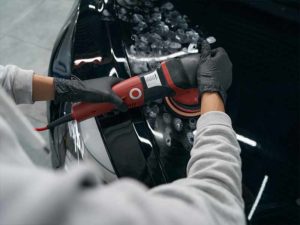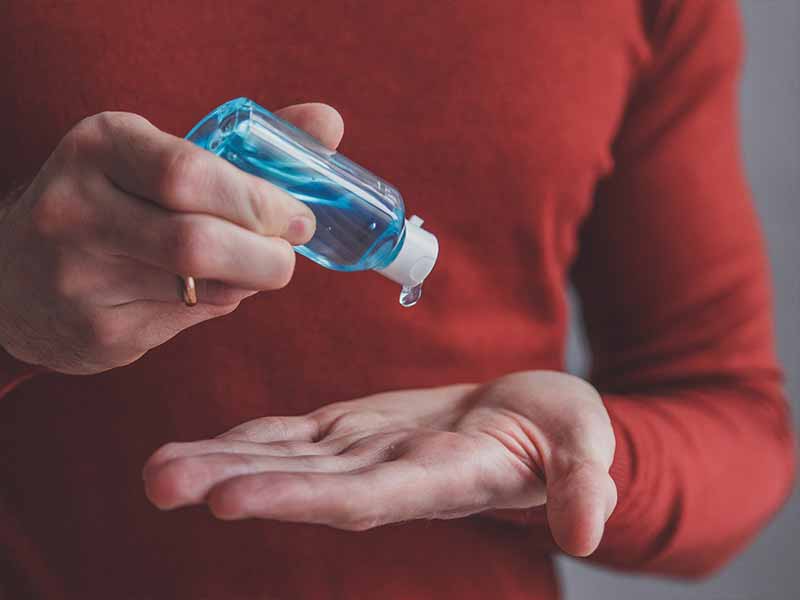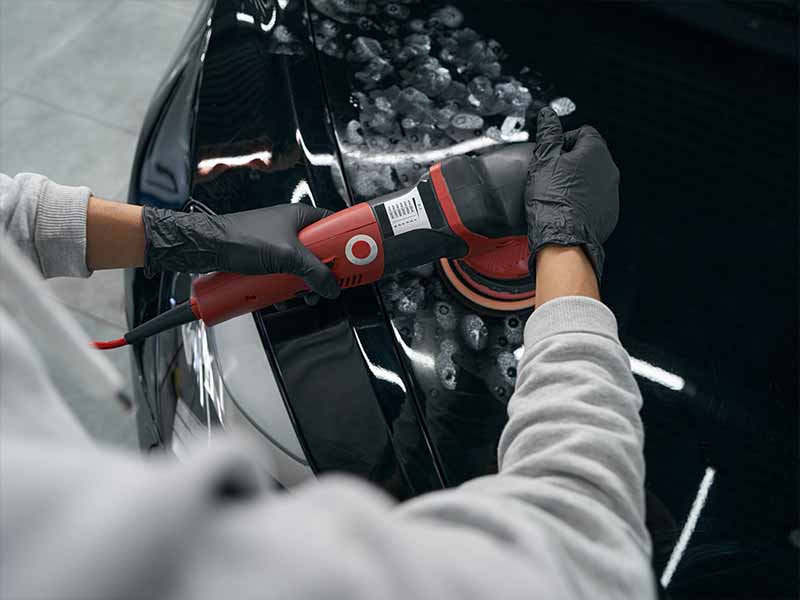Table of Contents
- Waffle Polishing Pad Vs Flat
- What Is a Polishing Pad?
- Uses for a Polishing Pad
- How Polishing Works
- Different Types of Polishing Pads
- All About Flat Polishing Pads
- All About Waffle Polishing Pads
- Pros of Waffle Polishing Pads
- Cons of Waffle Polishing Pads
- Pros of Flat Polishing Pads
- Cons of Flat Polishing Pads
- Avoid Melting Topcoat with a Different Polisher
- Which Is Right for You?
- Helpful Links
- Conclusion
Picking between a waffle and a flat polishing pad can be daunting. This is often the first step, and it will impact the rest of your polishing job.
In this guide, we’ll explain all the differences and determine which is right for you. Let’s get started with some definitions.
Waffle Polishing Pad Vs Flat
Waffle pads are very similar to flat pads but the waffle textured pads help to reduce heat buildup between the foam and the clear coat of your vehicle’s finish.
Textured pads cost more than flat pads, wear out more quickly, and requires a little more finesse to ensure the polisher doesn’t “walk” and remains very level with the paint surface.
What Is a Polishing Pad?
We should start by describing what a polishing pad is and how it works. This is a circular piece of material that gets installed on a polisher.
A polisher is a handheld power tool that will spin around and offer a much better version of polishing your car by hand. The pad goes on the polisher and then some product gets squirted on the pad before you start polishing your car.
The pad itself serves a very important purpose: it evenly and safely applies the polishing compound to your vehicle. It’s the only material that comes in contact with your car as you do a full polish.
As you might know, the topcoat of your car is very sensitive. Using the wrong material, applying too much heat, or incorrectly using a polisher can lead to some devastating damages. Specifically, you can melt and mar your topcoat which is an extremely expensive problem to have.
This is why your polishing pad selection is so important. If you were to just use a random sponge from your kitchen, you will likely do extensive damage to your car. Instead, you should pick a polishing pad that’s meant for automotive use.
There are a lot of decisions that need to be made when it comes to these pads. We’ll discuss this topic later, but each pad serves a specific purpose and has a whole list of pros and cons associated.

Uses for a Polishing Pad
The sole use for a polishing pad is to polish your vehicle. They are designed to work with a polisher and deliver a certain level of polishing.
Technically, there’s nothing stopping you from using one of these pads to polish your car by hand. However, the pad is pretty uncomfortable to hold and will take more effort. You can just use a microfiber towel or automotive-use applier instead.
How Polishing Works
The act of “polishing” is different than cleaning or waxing your car. Polishing happens after both of these events take place, and the sole purpose is to add a level of shininess to your car. Rather than adding a coat of protection, polishing will slightly remove a layer from your car’s topcoat.
Shininess happens when there’s a uniform layer of your topcoat. As you drive, little defects, scratches, and contamination will make your car look duller. Even after washing and waxing, these defects will hurt the overall presentation of your car.
This is when a detailer might choose to polish their car.
The polishing pad and solution will work together to uniformly scrape away the top layer of surface defects. This will reveal a smooth layer of topcoat which makes the car look much shinier.
As such, polishers are more abrasive than waxing agents or typical car washing soaps.
In addition to making your car look shinier, polishing is also a proven way to get rid of small “swirls” or scratches on your topcoat of paint. Again, this is achieved by removing a thin layer of your topcoat.
Different Types of Polishing Pads
We mentioned earlier that there are a lot of different types of polishing pads. The three common material types are wool, foam, and microfiber pads. In this case, we’ll be talking about foam pads.
Within the world of foam polishing pads, there are different configurations. These are constructed so that, on a minuscule level, different things are happening. The pore size in the foam will determine how much can be pulled from your car’s surface and how the polishing agent is applied.
The stiffness will impact how abrasive the pad is — changing how much or how little of your topcoat is taken away.
More importantly, there are different surface geometries that will impact your polish. We’re going to be talking all about waffle and flat polishing pads in the following sections.
All About Flat Polishing Pads
A flat polishing pad, also called a smooth pad, is pretty simple to understand. It uses a flat piece of foam to polish your car. Since it’s flat, a majority of the surface area will be touching your car for as long as you’re polishing.
This is the simpler option as far as foam pads go, and they are pretty universally available. They’ll work on most buffers, and you can find options from a variety of different manufacturers.

All About Waffle Polishing Pads
If you add some texture to a flat pad, you’re left with a waffle polishing pad. The name originates from its waffle-like geometry. It has rounded peaks and valleys across the pad, making half the pad raised and the other half sunken.
If you look at the pad head-on, the sunken areas will look like the recessed parts of a waffle.
Different geometries of foam pads play off the concept of a waffle pad. By reducing how much surface area is touching your car, there are some great benefits.
Pros of Waffle Polishing Pads
We’ll start with the pros and cons of a waffle polishing pad. This section will highlight the pros and the following will touch on some of the negative aspects.
Less Sling
“Sling” is a phenomenon where your polishing product gets thrown all over the place when you use an automatic polisher. It leaves you with a mess to clean up after the fact, and it’s pretty wasteful since the product never gets used.
With a waffle pad, you’ll experience less sling.
This is because less surface is in contact with your car. This creates less torque on the product, lessening the chance for any sling to happen.
Although slinging product isn’t the end of the world, it’s nice to avoid it in order to cut down on your cleanup time after.
Produces Less Heat
The biggest difference between these two types of pads is the level of heat they generate. By design, waffle polishing pads produce less heat.
In the world of polishing, heat is your car’s worst enemy. If you apply too much heat, then the topcoat will actually melt away. This is an expensive and lengthy fix, so it’s better to avoid it altogether.
Heat generation is a byproduct of friction, pressure, and surface area. The pressure is the same between both pad types. The friction is also largely the same since both pads are made with foam and roughly the same level of stiffness. The big difference is the surface area.
Since less pad is in contact with your car, less heat is generated.
The recessed portions also allow for some airflow. Air will transfer the heat and avoid hot spots as you polish your car.
Easier to Use
Another benefit of a waffle pad is that they’re typically easier to use. With a flat pad, you need to focus on constantly moving the machine around to avoid melting your topcoat. All the while, you need to ensure the pad is held flat against your car and you apply a consistent and even pressure.
With a waffle pad, you don’t have to worry about these concerns. Instead, you can focus on polishing your car and letting your mind wander.
There are still operational errors that can ruin your polish (as we’ll mention later), but it’s easier for a beginner to pick up a waffle pad and start polishing.

Cons of Waffle Polishing Pads
Next, let’s discuss some of the drawbacks. All of these are due to the geometry and shape of a waffle pad, since that’s the only discernable difference between these pads and flat ones.
More Expensive
First off, expect to pay more for these pads. They’re still very inexpensive, but they’re more costly than a flat pad is.
As you use pads more often and stock up, the difference in price will be more noticeable. It’s commonplace for manufacturers to sell pads in bulk, so you’ll see a big difference between a box of these pads and flat pads.
Wears Down Quicker
We mentioned that there’s less overall friction and less heat generated with waffle pads. However, these pads will wear down quicker than a flat one.
Why? It has to do with the surface area. Even though there’s less heat and friction, it’s being concentrated on smaller areas. The peaks of the waffle pad will very quickly wear down as compared to a flat pad.
With a flat pad, there’s more material sharing the energy. It’s akin to how quickly a pencil’s eraser wears down as compared to a large handheld eraser.
This means that you’ll need to replace your pads more often. When coupled with the higher price tag, this can be a concern for some consumers.
Less Cutting Power
Another byproduct of the waffle geometry is that there’s less cutting power. With a polisher, you want to cut into the topcoat and remove all the surface-level contaminants. Since there’s less friction, a waffle pad can’t offer the same results as a flat one.
Manufacturers can make up for this by using stiffer foams and different pore sizes, but a like-for-like comparison between a flat and waffle pad will show that the flat pad always cuts better.
Tends to “Walk”
Since these pads have a series of raises and depressions, it’s more difficult to keep the polisher steady. This is especially true as you start working around the different bends of your vehicle.
With a waffle pad, your tool will be more susceptible to “walking”. This is when the machine moves in one direction or another without your input. It happens due to the vibrations and uneven forces while the waffle pad is quickly rotating.
Unfortunately, it’s hard to prevent your tool from walking. One option is to lower the speed, further decreasing the cutting power of the pad. Another option is to apply more pressure.
This is something you’ll get the hang of as you get more experience with this pad.
Damaging if Not Used Flat
The biggest problem with a waffle pad is that it can fall apart if you don’t use it flat. If you approach at an angle or hit the corner of the pad on something, it’s not rare for the pad to break.
The foam was designed to handle pressure pushing directly against the front of the pad. Any force that comes at an angle other than that can break your pad.
With polishing, it’s important to keep your pad flat anyway. The only difference is that failing to do so with a flat pad won’t cause the pad to fall apart.

Pros of Flat Polishing Pads
Now it’s time to discuss flat polishing pads. We’ll start with the benefits then discuss the disadvantages after.
Less Expensive
Flat pads are downright inexpensive. There are times that you’ll find flat pads that are nearly half the price of waffle pads.
This doesn’t mean that they’re made cheaply. Rather, the manufacturing process is very easy, and they can be quickly made. As a result, flat pads are the least expensive option as far as foam pads are concerned.
Lasts Longer
Since there is more surface area, your flat polishing pads will last longer than waffle ones. Since the pad isn’t contingent on the geometry of the face, it also means that you can use these pads for longer.
As waffle pads wear down, they quickly lose their functionality. Once the peaks are worn down, they’re not really waffle pads anymore. With flat pads, the pad will always be flat and usable.
With flat pads, you’ll need to replace them after they get too thin. They’ll still be functional up until that point.
Finishes the Job Quicker
The good part of the added friction and heat of a flat pad is that they’ll get the job done quicker. With a waffle pad, you will often find yourself going over the same area a few times before getting a good shine.
With a flat pad, you’ll move through each section quicker. As a result, you’ll finish polishing your whole vehicle faster.
For professional shops, this means getting cars done quicker and making more money each day.
Cuts Deeper
The simple fact is that flat pads are going to cut deeper than a waffle pad. The added friction and surface area work wonders at cutting into the topcoat of a car.
This allows you to get out deeper surface imperfections with a flat pad. There are instances when we couldn’t get out a scratch with a waffle pad, but it came out with a flat pad.
Creates a Better Shine
With a deeper and more uniform cut, your car will be shinier. That’s the end goal for a lot of customers who use a polisher in the first place.
With a trained eye, the difference is pretty noticeable. Even a beginner can notice the difference in a side-by-side comparison.
Cons of Flat Polishing Pads
There are a few disadvantages that we should discuss. These are reasons why some people won’t use flat pads.
Harder to Use
The technique behind polishing with a flat pad is more difficult. With a waffle pad, a beginner could pick up the polisher and get pretty good results.
With flat pads, there’s a big concern about how quickly you move the tool. Staying in one place for too long will overheat the area and melt the topcoat.
In addition, the tool needs to be perfectly parallel with the surface that’s getting polished. Waffle pads are a bit more forgiving with this (as long as you don’t send the waffle pad into the car at a bad angle).
Can Melt Your Topcoat
The biggest downside is that flat pads can melt your topcoat. We’ve mentioned this a few times so far, and it’s worth repeating it again.
A waffle pad generates a lot less heat than a flat pad. With improper technique, it’s very easy to melt your topcoat using a flat pad.

Avoid Melting Topcoat with a Different Polisher
There’s a way to avoid the risk of melting your topcoat. Instead of using a traditional orbital polisher, you can use a dual-action polisher. This tool was specifically made for beginners and people who want to avoid damaging their topcoat.
An orbital buffer will spin your pad about the center point of your pad. If you turn the tool on and stare at the pad, you’ll notice that it only rotates, it doesn’t move from the center.
A dual-action polisher purposefully moves your pad around while still spinning it. It moves in an always-changing orbit like the moon around the Earth.
By doing this, there’s no risk of heating up a single area of your car. Instead, the heat is shared around the area.
What’s the point of talking about this polisher? Well, you’ll notice that the two biggest disadvantages of flat pads are that they can melt your topcoat and they’re hard to use. If you swap to a dual-action polisher, these downsides become minimized.
The tool itself will make flat pads a great option.
Which Is Right for You?
At this point, you want to know which pad option is right for you. To make it easy, we broke it down to address the three types of polishing you can do with this pad:
For people hand polishing with a pad — It doesn’t matter. Either option can be used, but both would be pretty uncomfortable. Instead, use an applicator pad that’s designed for automotive use.
For people using an orbital buffer — A waffle pad is preferred. It does a better job of dissipating heat and runs a lower risk of melting your topcoat. It might take you longer and cost more money, but the benefits outweigh the negatives in this case.
For people using a dual-action polisher — Either option will work, but a flat pad is preferred. It works quicker, costs less money, and gives a better shine than a waffle pad. Plus, the tool is doing exactly what a waffle pad aims to do in the first place.
Bonus: For auto detailers — Use flat pads. They’re less expensive and will finish the job quicker. We assume that you already have plenty of experience with polishing, so there are fewer risks.
Helpful Links
Conclusion
As you can see, both of these pads have their own list of pros and cons. We hope that you have a better idea of which pad is right for you.
For more DIY detail guides, explore the rest of our blog.









